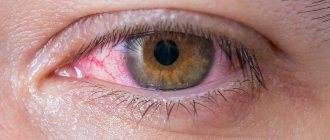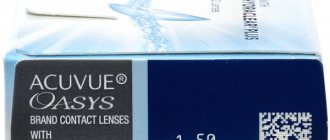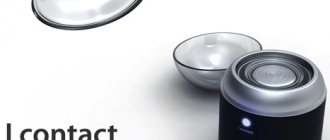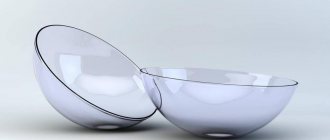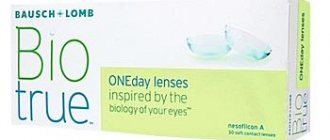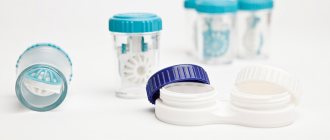What you need to know about wearing contact lenses.
You must strictly follow your eye care professional's instructions regarding the use and care of contact lenses and the use of contact lens care products, including lens storage containers.
Failure to properly wear and care for contact lenses can result in serious eye damage. Contact lenses with UV protection do not eliminate the need for sunglasses, as they do not fully cover the eye and area around the eyes.
Long-term exposure to UV radiation is one of the factors influencing the development of cataracts. The degree of impact depends on many factors (geography, weather conditions, distance from sea level, individual characteristics, etc.).
Contact lenses with UV protection help protect your eyes from the harmful effects of ultraviolet radiation. However, there are no clinical studies showing a reduction in the risk of developing cataracts or other eye changes caused by exposure to UV radiation. Contact your eye care provider for more information.
Contraindications
Do not use lenses if you have the following eye conditions:
- inflammation or infection in the area around the eyes or on the eyelids;
- any eye disease, injury or abnormality affecting the cornea, conjunctiva or eyelids;
- severe dry eyes;
- decreased sensitivity of the cornea;
- any systemic diseases that may affect the eyeball or complicate the wearing of contact lenses;
- allergic diseases of the surface of the eye or adjacent tissues;
- any acute infectious diseases of the cornea and conjunctiva.
It is not recommended to wear contact lenses if you have colds or flu. Your doctor may prescribe contact lenses to help treat certain eye conditions, which may include the conditions listed above.
Maintaining hygiene and hand washing
Preparing to install the lens
Cleanliness is the main and most important condition for proper lens care.
You must have good hygiene skills when handling lenses.
- Before touching your lenses, always wash your hands thoroughly with mild soap, rinse well, and dry them with a lint-free towel.
- Avoid using greasy cosmetic lotions and creams before touching your lenses. It is recommended to install lenses before applying makeup.
- Cover your eyes when using hairspray, deodorant, air freshener, or other aerosols.
- Always follow the instructions on this page of our website, as well as all recommendations from your ophthalmologist regarding the handling, installation, removal, cleaning, disinfection and storage of lenses.
- Never wear contact lenses longer than they were designed to last.
Opening the package and blister with a contact lens.
Each lens is in an individual blister, ensuring its sterility. Do not use a contact lens if you find that the blister pack is damaged.
To open a blister with a lens, follow these simple steps:
- Separate the blister with one lens from the rest. Be careful not to damage the remaining blisters.
- Shake the contact lens blister and make sure the lens floats freely in the solution.
- Separate the foil from the blister. Sometimes, when opened, the lens may stick to the inner surface of the foil or to the wall of the blister itself. This does not affect the sterility of the contact lens.
- Handle contact lenses very carefully, touching them with your fingertips, and try not to damage them with your nails.
- Carefully remove the lens from the blister. If necessary, you can use special tweezers for contact lenses with soft tips.
How to handle contact lenses
To avoid getting your lenses mixed up, develop the habit of always starting the lens placement on your right eye.
Inspect the lens to make sure there are no tears or wrinkles at the edges. If your contact lens appears damaged, do not use it.
Also make sure that the contact lens is not turned inside out. To do this, place the lens on the tip of your index finger so that it faces up, like a cup. The center of the lens should touch the fingertip. Edges up. Raise your finger with the lens to eye level and inspect the contact lens. If the lens resembles a cup when viewed from the side, then it is not inverted. If the edges of the lens do not tend upward, but to the sides, like a plate, then this is an incorrect position. In this case, unscrew the lens and continue further manipulations.
Some contact lenses are marked on the edge with letters or numbers ( 123 ). This makes it easier to determine the correct lens position.
Note : If necessary, you can rinse the lens before placing it on your eye. Use only fresh, sterile solution.
Never use tap water.
Step-by-step instruction
The sequence of the lens fitting procedure is almost the same for all types of optical products. Products must be removed after a few hours and at night .
Putting on and removing contact lenses should be done with thoroughly washed hands. Then the following actions are performed:
- Your eyes are directed upward; you can use a mirror if it is more convenient for you.
- Using your index finger, you need to find the lower part of the lens.
- Carefully move the product down or to the side. Then, hooking it with a finger, it is removed from the eye.
- After this, the lenses, one by one, are transferred to a container with a disinfectant solution.
ATTENTION! The disinfectant liquid where the lenses are placed for storage must be changed daily, in extreme cases this is done once every 3 days. This way, a person’s eyes will be clean, which means their health will not be affected.
How to install a contact lens on your eye
- Start by placing the lens on your right eye. Place the lens on the pad of your index finger and make sure the lens is not turned inside out.
- Place the middle finger of the same hand near the eyelash line and use it to pull the lower eyelid down.
- Move your gaze upward and fixate.
- Place the contact lens on the eyeball. It is advisable that the lens rests along its entire diameter at once. In this case, if necessary, you can hold the upper eyelid with the fingers of your other hand.
- Gently move your finger away from the eyeball. Make sure the lens remains on the eye. Smoothly lower your gaze down to where the lens is. Release the lower eyelid and only then gently gently lower the upper eyelid. Blink.
- Typically, the contact lens is automatically positioned in the middle of the cornea at the time of insertion. However, if this does not happen, then close your eyelids and gently move the lens into place using massaging movements through closed eyelids OR gently move the displaced lens back to the middle of the cornea with open eyelids by pressing your finger on the edge of the upper or lower eyelid.
- Repeat the same manipulations to install the contact line on the left eye.
Note : If you cannot see clearly after installing the lens, this may be due to the following reasons:
- -The lens is not installed in the center of the cornea. In this case, follow the instructions above
- -If the lens is in the correct position, then remove it and check if the following points occur:
1. The lens is dirty (for example, with cosmetics). Rinse the lens thoroughly with the solution, or better yet, throw it away and install a new one.
2. The lens is placed in the wrong eye.
3. The lens is turned outward
Instructions on how to do this easily every day
To summarize what has been said, the main points of putting on lenses should be mentioned:
- Clean hands.
- Always start the application procedure with the same eye, then you will not get confused about which lens is suitable for which eye. There is no need to swap them.
- After opening the container, use tweezers to remove the lens and inspect it in the light for damage.
- The lens is placed on the base of the finger with the edges up. If it is not completely turned out, do it with tweezers.
- Place the lens on the pupil, keeping the eyes wide open; if necessary, use your fingers to push back the lower eyelid. It should immediately stick to the pupil, then slowly close your eyelids and lower the pupil down.
- After a few seconds, you need to blink so that the lens fits well; if after this your vision improves, then you did everything right.
- If there is discomfort, pain, burning, or a feeling of a foreign object in the eye, you must remove the optical product. This is done by running a finger from the outer corner of the eye to the inner one. So the product comes out, it is washed in liquid and wait until the irritation in the eye subsides. Then they try to put it on again.
IMPORTANT. Often, wearing these optical products leads to dry eyes, so you should ask your ophthalmologist in advance about what drops or gels exist to eliminate this deficiency.
How to remove a contact lens
Always remove the lens you started with first.
Before removing the lens, wash your hands thoroughly and follow the hygiene rules described above in the “Hygiene and Handwashing” section.
Further:
- Looking up, use your index finger to move the lens from the cornea down to the white part (sclera).
- Gently squeeze the lens between your index finger and thumb and remove it.
- Repeat the same steps to remove the contact lens from the other eye.
Security control
You should carry out a simple self-test at least once a day.
Ask yourself the following questions:
How do I feel wearing contact lenses?
- What do my eyes look like?
- Can I still see well with contact lenses?
You should remove your contact lens immediately if any of the following problems occur:
- -Feeling of itching, burning and tingling in the eye.
- -Feeling of a foreign body.
- - Excessive prolonged lacrimation, unusual discharge from the eyes.
- - Pronounced hyperemia (redness) of the eyes.
- -A veil before the eyes, rainbow glare or halos around objects.
- -If you wear contact lenses continuously or for too long, your eyes may feel dry.
- -The lenses feel less comfortable than when they were first worn.
If discomfort or other problems disappear after removing the lenses, carefully inspect the lenses for damage, contamination, or foreign matter.
If discomfort or other problems continue after installing a new lens, remove the new lens and consult an ophthalmologist.
Precautionary measures
- Remove lenses immediately if your eyes become red or irritated.
- Strictly observe hygiene requirements.
- Don't sleep with your lenses on - remove your contact lenses before going to bed.
- Never use tap water on contact lenses.
- Do not use any eye drops with the lens on the eye other than special moisturizing drops.
- Any contact lenses must be worn in strict accordance with the terms of their wearing. For example, daily contact lenses such as Acuvue 1 day Miost, Acuvue TruEye, Dailies Aqua Comfort Plus, Daysoft, Soflens daily disposable and others are designed to be worn for only one day. Once removed, these lenses are discarded.
- Apply eye makeup after putting on the lenses. Remove eye makeup after removing your contact lens from your eye.
- Cover your eyes when using any aerosols.
- During the period of illness with acute viral diseases, it is better not to wear contact lenses.
- Some medications, such as antihistamines, runny nose medications, diuretics, muscle relaxants, tranquilizers, and motion sickness medications, can cause dry eye mucosa and a sensation of a lens being on the eye.
- Taking oral contraceptives may cause blurred vision or impair tolerance of contact lenses. In such cases, consult your doctor.
- Avoid exposure to any harmful or irritating fumes or fumes while wearing contact lenses.
- If chemicals come into contact with your eyes, rinse your eyes immediately with running water. Contact your eye doctor or your nearest hospital emergency room right away.
- Always carry glasses with you so that you can remove the lenses if necessary.
Recommendations
- Always disinfect your lenses thoroughly;
- If you notice any damage on the surface of the lenses, stop using them;
- If you feel any discomfort while wearing lenses or after removing them, contact your ophthalmologist;
- if the lens is stuck and removing it causes discomfort, drop a couple of drops of a special moisturizing solution into the eye and remove it as usual;
- to avoid mixing up the lenses, label each container with the letters “P” (right) and “L” (left);
- Be sure to change your lens containers at least once a month!


